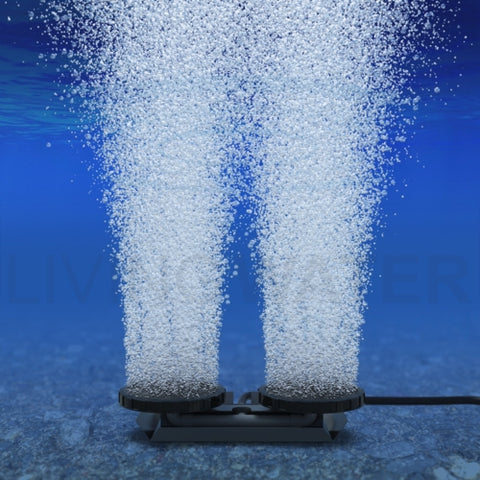Pond Aeration Information
The Benefits of Pond Aeration
If you have answered yes to any of the above questions or want to improve your water quality -- read this info!
What is pond Aeration?
"Aeration" is the term that we use to mean adding air to the water.
Because air contains 22% oxygen aeration adds oxygen to the water.
If you have answered yes to any of the questions above your problem may be due to insufficient levels of oxygen in your pond.
Ponds that are deeper than 6 ft. simply are not capable of producing significant levels of oxygen at those depths. Below is an illustration that will show you the problem:

The good health of a pond is held in a delicate balance. A pond's condition deteriorates when its bottom environment cannot support animal life. The bottom is the area that runs out of oxygen first (the bottom is where the most oxygen is used and is the farthest from the surface where it is replenished). The absence of oxygen kills all of the bottom dwelling animals that help keep a pond clean. The loss of these animals (snails,mussels, worms, etc.) will greatly reduce the pond's ability to clean itself.
Nutrients (fish waste, grass clippings, dead algae, etc.) cause most water quality problems. Nutrients are cleaned from a pond's bottom by the small bottom dwelling animals mentioned above. When these animals do not exist the nutrients accumulate on the bottom forming a layer of "muck" which serves as fertilizer for weeds and algae. If a pond is allowed to get seriously infested with weeds, herbicide treatment may be the only way to gain control. The idea is to prevent such infestation in the first place. Natural water cleanup through aeration offers preventative maintenance, reducing sediment before more serious problems arise.

Pond Aeration - By pumping compressed air out into a pond or lake bed aerator -- an air diffuser that produces tiny air bubbles -- the rising air bubbles bring bottom water to the surface where it is exposed to the atmosphere. Large volumes of water thus lose bad gasses to the atmosphere and the water picks up even more oxygen while on the surface
Surface Splashers Vs. Diffused Pond Aeration
Surface Splashers include but are not limited to the following:
-Look at the illustration below and notice how a diffuser will saturate the entire pond with oxygen and not just the surface. Unfortunately, as you can see the surface units expose just surface water to the atmosphere. NOT deep water.

vs

- Fountains are a popular choice when a decorative aerator is desired. Fountains splash the surface of the pond and help control surface algae and duckweed, but do not aerate down to the bottom in deep ponds.
- Diffused pond aeration is the best way to aerate deep ponds. Because the air diffuser lays on the bottom you achieve total pond aeration from top to bottom regardless of depth.
Diffused aeration systems are the best way to aerate, destratify and create circulation on ponds over 6' deep. Each system has three basic parts:
1. Air compressor
2. Air hose
3. Air diffuser
The air compressor sits on shore and pumps air out through the hose to the air diffuser located on the bottom of the pond. The result is thousands of tiny bubbles rushing out of the diffuser to the pond surface, creating circulation and providing aeration. There are several advantages to using diffused pond aeration kits instead of surface aerator:
1. Electric motor is on shore, not in the water;
2. Air diffusers lay on the bottom, ensuring aeration of entire pond from bottom to top, regardless of depth size;
3. With proper sizing, tubing lengths up to 2000' can be achieved for ponds without electricity nearby.
-Oxygen is most needed at the bottom or deepest part of a pond.
-Surface Splashers can also be a safety hazard, electric wires need to be ran from your power source out to the motors in the water
Please Note: We do recommend Surface Splashers for ponds that have a maximum depth of 5' or less. Diffused Aerators are not recommended in shallow water.
How do I know that I am purchasing the right size unit for my pond?
The deeper an air diffuser is located, the more boiling action it will create and a larger area will be aerated. Therefore the deeper your pond the less CFM needed to aerate your pond. 1.5 CFM of air can effectively aerate a 1 Acre pond at a depth of 12' or deeper. The chart below can be used to determine the size of the compressor that you will need, it is based on a compressor producing 1.5 CFM of air.

Below is two links to our diffused aeration kits. The kits are organized smallest to largest and the maximum pond size is included in the description to assist you in selecting the right size kit for your pond.
Diffused Pond Aeration Kits (without cabinet)
Deluxe Diffused Pond Aerators (same as above but includes cabinet)